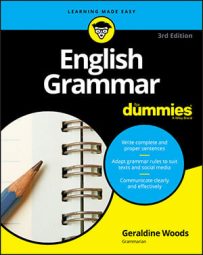Simultaneous events
Verbals often show up when two events take place at the same time. In the following sentences, check out the italicized verbals. Also keep your eye on the main verb, which is underlined. Notice that the same verbal matches with present, past, and future verbs and places the two actions at the same time or close enough in time to make the difference irrelevant. Also notice that none of the verbals are formed with the words have or had. (Have and had help to express actions taking place at different times.)Selecting a handkerchief, Maya daintily blows her nose. (The selecting and the blowing take place at nearly the same time — in the present.)Another variation:Selecting a handkerchief, Maya daintily blew her nose. (The selecting and the blowing took place at nearly the same time — in the past.)
Selecting a handkerchief, Maya will daintily blow her nose. (The selecting and the blowing will take place at nearly the same time — in the future.)
To blow her nose daintily, Maya selects a handkerchief. (The blowing and the selecting take place at nearly the same time — in the present.)No one in the known universe needs this information, so continue reading only if you love grammatical terms. Participles are verb forms that may act as adjectives. In the preceding example sentences, selecting is a present participle, and selecting a handkerchief is a participial phrase describing Maya. The action expressed by the present participle takes place at the same time (or nearly the same time) as the action expressed by the main verb. To blow is an infinitive, the basic form of a verb. Infinitives never function as verbs in the sentence. In the previous example sentences, to blow her noise daintily is an infinitive phrase describing Maya.To blow her nose daintily, Maya selected a handkerchief. (The blowing and the selecting took place at nearly the same time — in the past.)
To blow her nose daintily, Maya will select a handkerchief. (The blowing and the selecting will take place at nearly the same time — in the future.)
Different times
When verbals express actions or states of being that occur at different times, a helping verb (having or have) is involved.This topic is a favorite of standardized test-makers.
Check out this sentence:Having sealed the letter containing his job application, Nobrain remembered his name.

In other words, Nobrain's job application — unless he rips open the envelope — is anonymous because the sealing of the letter took place before the remembering of his name.
Here are additional examples:
Having finished her homework, Elizabeth turned on the television to watch the algebra tournament. (Event 1: Elizabeth finishes her homework at 2 a.m. Event 2: The tournament begins at 3 a.m. The networks seem reluctant to broadcast the match during prime time.)If you have a life, skip this paragraph. If you like grammar, read on to learn the technical terms. The present participle (finishing, for example) combines with present, past, and future verbs to show two events happening at the same time or at nearly the same time. The present perfect form of the participle (having finished) combines with present, past, and future verbs to show two events happening at different times.Having won all the votes, Lola named herself "Empress-in-Chief." (Event 1: Lola gets 100 percent of the votes. Event 2: Lola goes crown shopping.)
Having exhibited the painting in Mel's new gallery, Elizabeth considered herself an all-around artistic genius. (Event 1: Elizabeth convinces Mel to hang her Homework Blues portrait. Event 2: Elizabeth adds an art link to her Facebook page.)
Another one of the verb-forms-that-aren't-verbs, the infinitive, may also show events happening at two different times. The present perfect infinitive (to have finished, for example) is the one that does this job. Don't worry about the name; just look for the have. Here's an example:
It was helpful to have bought the cookbook before the dinner party. (Event 1: Pre-party, panicked trip to the bookstore. Event 2: Guests arrive, unaware that they're about to eat Alfalfa-Stringbean Surprise.)
The have form (the present perfect form) of the infinitive always places an event before another in the past. Don't use the have form unless you're putting events in order:
WRONG: I was wrong to have attended the party.Which sentence shows two events happening at the same time, and which shows two events happening at different times?RIGHT: I was wrong to attend the party. The music was terrible and there was nothing to eat but overcooked vegetables.
ALSO RIGHT: I was wrong to have said I would attend the party before I got a chance to investigate the menu. Mark's cooking was terrible.
A. Running up the clock, the mouse chatted with his friends.Answer: Sentence A shows two events happening at the same time. The mouse is running and chatting with his friends. Sentence B shows two events happening at different times. The mouse has arrived at the top of the clock and is now chatting with his friends. (Notice that the word having is involved, indicating that different events are occurring at different times.)B. Having run up the clock, the mouse chatted with his friends.

